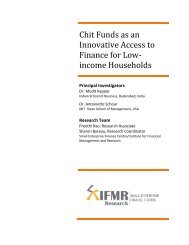Government of India Volume I: Analysis and Recommendations
Government of India Volume I: Analysis and Recommendations
Government of India Volume I: Analysis and Recommendations
You also want an ePaper? Increase the reach of your titles
YUMPU automatically turns print PDFs into web optimized ePapers that Google loves.
ANNEXES<br />
(b) Efficiency <strong>of</strong> DRT: Suitably amend RDDBFI to place an obligation on the appropriate<br />
entity to ensure efficient <strong>and</strong> effective functioning <strong>of</strong> the system.<br />
(c) Training <strong>of</strong> judicial <strong>and</strong> recovery <strong>of</strong>ficers: Suitably amend RDDBFI <strong>and</strong> SAR-<br />
FAESI to place a duty on the appropriate entity for training <strong>of</strong> judicial <strong>and</strong> recovery<br />
<strong>of</strong>ficers.<br />
(d) Uniform procedures: Amend RDDBFI to reflect the principle that uniform<br />
procedures must be followed by all DRTs.<br />
(e) Comprehensive rules on procedures: Detailed rules <strong>of</strong> procedure under<br />
the Civil Procedure Code, 1908 <strong>and</strong> rules <strong>of</strong> evidence under the <strong>India</strong>n Evidence<br />
Act, 1872 are not required to be followed. Keeping this in mind, the<br />
rules <strong>of</strong> procedure for DRTs under RDDBFI, namely the Debt Recovery Tribunal<br />
Rules, 1993, were drafted. The rules <strong>of</strong> procedure were intended to be light<br />
touch by allowing significant liberty to the tribunals to devise their own methods<br />
<strong>and</strong> st<strong>and</strong>ards This has led to inconsistent <strong>and</strong> differing approaches taken<br />
by different DRTs. There is a need to set out comprehensive if not detailed, set<br />
<strong>of</strong> rules <strong>of</strong> procedure applicable to hearings before DRT to increase certainty<br />
<strong>of</strong> procedure <strong>and</strong> provide guidance to practitioners.<br />
(f) Quantitative measurements <strong>of</strong> performance: Amend RDDBFI <strong>and</strong> SARFAESI<br />
to ensure reporting requirements by appropriate authorities for preparing annual<br />
reports which detail revenues received through filing fees, resource allocation,<br />
steps taken towards efficient functioning <strong>of</strong> the tribunals, statistical<br />
analysis <strong>of</strong> cases <strong>and</strong> workload, time taken to dispose cases, <strong>and</strong> reasons for<br />
delay.<br />
(g) Funding <strong>and</strong> resource allocation: There is a need to rethink the funding <strong>and</strong><br />
resource allocation for DRTs in <strong>India</strong>. Tribunals do not function efficiently if<br />
they are not well funded <strong>and</strong> do not have sufficient resources at their disposal.<br />
The recommendations are two fold:<br />
i. Independence: Currently, resource allocation for DRTs is done through<br />
the Ministry <strong>of</strong> Finance, through the budgetary process. Financial sector<br />
regulators in <strong>India</strong>, such as SEBI <strong>and</strong> IRDA, have the ability to charge fees<br />
from regulated entities to cover the cost <strong>of</strong> their functioning. Independence<br />
in funding <strong>and</strong> resource allocation is important for effective functioning<br />
as it allows the entity the operational flexibility. The recommendation<br />
is therefore to amend RDDBFI recognising the principle <strong>of</strong> independent<br />
resource allocation.<br />
ii. Quantum <strong>of</strong> fees: There is merit in empowering the DRTs to determine<br />
the filing fees by keeping in mind the overall costs for their effective functioning.<br />
The applicants who file petitions before DRTs are financial institutions<br />
which can afford to pay for speedy recovery <strong>of</strong> loans made by<br />
them. 2 Currently, only the Central <strong>Government</strong> has the power to make<br />
regulations prescribing the fees. Since the recommendation <strong>of</strong> this WG<br />
is to grant more independence to DRTs for allocating resources, deciding<br />
the quantum <strong>of</strong> fees should be their prerogative <strong>and</strong> is a necessary outcome<br />
<strong>of</strong> such independence.<br />
(h) Adopting information technology: <strong>India</strong>n courts have been slow in adopting<br />
information technology. While there has been some improvements in<br />
communication to the public through websites; there is no movement towards<br />
integrating the entire court process into an electronic form. Digitisation<br />
<strong>of</strong> court records <strong>and</strong> computerisation <strong>of</strong> registries would be beneficial<br />
2 At present, the cost <strong>of</strong> filing an original application before the DRT is Rs. 12,000 when the amount <strong>of</strong> debt owed<br />
is Rs. 10 lakhs, subject to a maximum cap <strong>of</strong> Rs. 1.50 lakhs.<br />
FINANCIAL SECTOR LEGISLATIVE REFORMS COMMISSION 189



